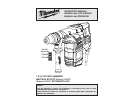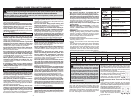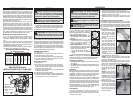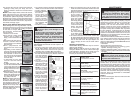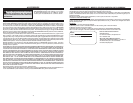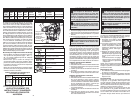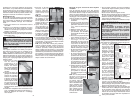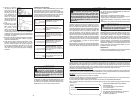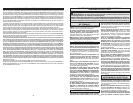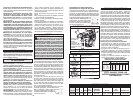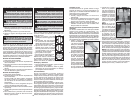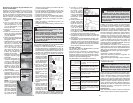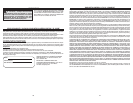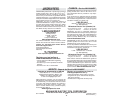
6
7
MAINTENANCE
WARNING To reduce the risk of injury,
always unplug your tool before
performing any maintenance. Never disas-
semble the tool or try to do any rewiring
on the tool’s electrical system. Contact a
MILWAUKEE service facility for ALL repairs.
Maintaining Tools
Keep your tool in good repair by adopting a regular
maintenance program. Before use, examine the
general condition of your tool. Inspect guards,
switches, tool cord set and extension cord for
damage. Check for loose screws, misalignment,
binding of moving parts, improper mounting, bro-
ken parts and any other condition that may affect
its safe operation. If abnormal noise or vibration
occurs, turn the tool off immediately and have the
problem corrected before further use. Do not use a
damaged tool. Tag damaged tools “DO NOT USE”
until repaired (see “Repairs”).
Under normal conditions, relubrication is not neces-
sary until the motor brushes need to be replaced.
After six months to one year, depending on use,
return your tool to the nearest MILWAUKEE service
facility for the following:
• Lubrication
• Brush inspection and replacement
• Mechanical inspection and cleaning (gears,
spindles, bearings, housing, etc.)
• Electrical inspection (switch, cord, armature, etc.)
• Testing to assure proper mechanical and electrical
operation
WARNING To reduce the risk of injury,
electric shock and damage to the
tool, never immerse your tool in liquid or allow
a liquid to fl ow inside the tool.
Cleaning
Clean dust and debris from vents. Keep the tool
handles clean, dry and free of oil or grease. Use
only mild soap and a damp cloth to clean your tool
since certain cleaning agents and solvents are
harmful to plastics and other insulated parts. Some
of these include: gasoline, turpentine, lacquer thin-
ner, paint thinner, chlorinated cleaning solvents,
ammonia and household detergents containing
ammonia. Never use fl ammable or combustible
solvents around tools.
Repairs
If your tool is damaged, return the entire tool to the
nearest service center.
6. To change the core bit, hold the tool upwards,
pointing it away from your body, and run it
briefl y in forward to loosen the core bit from the
adapter.
NOTE: To make deeper holes, remove the core bit,
break and remove the core, then resume drilling.
When drilling long or deep holes, after each inch
of penetration pull the bit partially out of the hole
while the tool is running, to help clear dust from the
bit fl utes. Dust can clog the bit fl utes and can make
the bit bind in the hole. If this occurs, stop the tool,
free the bit and begin again.
Drilling Large Diameter Holes with Core Bits
When drilling holes with large diameter core bits,
dust may build up in the cut and can cause the tool
to stall, bind, or cut slowly. By creating an opening
for the dust to escape, drilling
time, bit stress, and tool stress
can be reduced.
1. Start the cut as normal.
2. Once the bit is fi rmly estab-
lished in the cut (about 1/4"
deep), remove the bit from the
cut.
3. Remove the bit from the tool.
4. Install a standard fluted bit,
approximately 7/8" in diameter,
onto the tool.
5. Drill a perpendicular hole
through the kerf of the large
hole.
• Depending on the location of
the work, the hole should either
break through the other side of
the hole/fl oor or extend 4"-5"
past the end of the workpiece
(such as into the dirt below a
concrete slab).
• If dust builds up in the hole,
vacuum it out and continue
drilling.
• If drilling through a wall, the
hole for dust should be drilled on the lowest part
of the large hole kerf as
the dust will fall there when
drilling and can be evacu-
ated more easily.
6. Reinstall the core bit and
continue drilling. Dust and
debris will fall through the
hole and optimize the cut-
ting ability of the bit.
NOTE: If unable to drill a hole
in the kerf, pull back on the
bit with the hammer running.
This will remove some of the
dust and debris from the cut.
Repeat this for every inch of
drilling. If necessary, vacuum
dust and debris from the cut
and surrounding area.
Cut
approximately
1/4" deep with
a core bit.
Side view
of slab
Pull bit out as far
as possible once
or twice per inch
drilled.
Drill a hole
through the
work.
Dust and debris
will fall through
the hole.
Top view
Setting Self-Drilling Anchors
MILWAUKEE Tooth Anchor Chucks require a “B”
taper adapter.
1. Place the proper size tooth anchor chuck into
the “B” taper adapter. Then insert the “B” taper
adapter into the tool and lock it into place as
described. See “Installing Bits and Chisels”.
2. Insert the anchor into the tooth anchor chuck. Set
the knob for hammering only. Set the anchor on
your mark and ham-
mer until the teeth
have penetrated the
concrete.
3. Set the knob for
hammering with
rotation and drill until
the chuck is 1/8"
above the concrete.
NOTE: It may be
necessary to clean
dust and cuttings
from the anchor
several times while
drilling the hole.
4. Remove the anchor
from the hole while
the tool is running.
Clean the dust and
cuttings from the an-
chor by pointing it
downward and turn-
ing the tool on and
off several times.
Clean the dust out
of the hole with a
vacuum cleaner or blowout bulb.
Scaling Chisels
For removing weld spatter or
scale and cutting straight lines.
Bushing Tools
Used to surface concrete.
Mortar Cutting Chisels
(Seam Tools)
For removing old mortar for tuck
pointing or caulking.
Bull Points
For demolition work and starting
holes in concrete slabs.
Flat Chisels
For edging, chipping or
channeling.
Slotting Chisel
For slotting and cutting between
drilled holes in concrete and
masonry.
WARNING To reduce the risk of
personal injury and damage to the
tool or work:
• Always use the “hammering-only” setting to
set the anchor. Never use the “hammering-
with-rotation” setting to set the anchor.
• Never switch the tool to “hammering-with-
rotation” until after the anchor has been
set and the tooth anchor chuck has been
removed from the anchor.
1/8"
7. For core bits, once the maximum core bit depth is
drilled, the core must be broken and removed.
• Install a chisel bit.
• Place the chisel into
the hole kerf.
• Chisel down into
the kerf at several
points until the core
is loose or broken.
• Remove the core
and vacuum/remove
any remaining dust
and debris.
• Install the core bit and continue the cut.
5. Place the expansion plug into the anchor and
insert the anchor into the hole. Switch the knob
back to hammering only, and hammer the anchor
fi rmly into the hole.
6. Snap the head off
of the anchor. To
remove the head of
anchors up to 5/8",
grasp the handles
firmly and pull the
tool sharply towards
you or snap off the
anchor head with
a hand hammer as
shown. The anchor
is now ready to re-
ceive a bolt.
7. To remove the an-
chor head wedged
in the tooth anchor
chuck, use drift pin 48-86-0100.
8. To remove the tooth anchor chuck, remove the
“B” taper adapter from the nose of the tool. Insert
the drift pin supplied with the adapter into the
hole on the side of the “B” taper adapter and
strike it sharply to force out the tooth anchor
chuck.
Chiseling and Chipping
MILWAUKEE Rotary Hammers may be used for
chipping and chiseling.
When chiseling, hold the tool at an angle to the
workpiece. Work from a corner or close to the edge
of the workpiece, breaking off one small area at a
time rather than attempting too large an area.
A variety of accessories are available.



